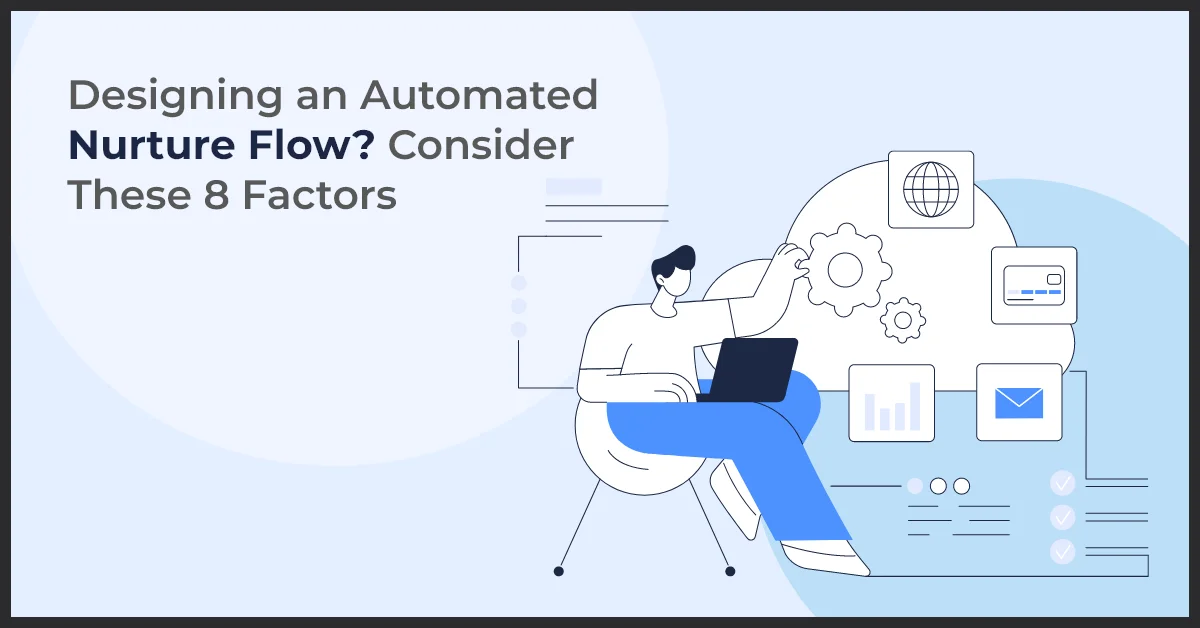Key Factors to Consider When Designing an Automated Nurture Flow

Published on: July 25, 2022
Updated on: March 10, 2025
2398 Views
- Marketing Automation
15 min read
As a marketer, you do everything perfectly. You create and run a marketing campaign that ensures thousands of new contacts lined up in your marketing automation suite. But, what next? You feel stuck, wondering how do you move them down the funnel? How do you get them to know more about your business and finally convert them into repeat customers?
For sure, this is challenging.
You may successfully attract prospects with your content to visit your website, but may not be always able to convince them enough to buy.
But one thing that you can always do is increase your chances considerably with a lead nurturing program. Lead nurturing involves a sequence of well crafted messages and experiences delivered via perfect marketing channels at the perfect time. But do you know what is even better? Automated lead nurturing.
Automated lead nurturing builds stronger bonds with leads to produce better results. You can more readily transform prospects into marketing qualified leads (MQLs), increasing brand recognition and sales conversion. These marketing automation procedures help you save time, money, and risk of human error. The automatic nurturing program is simple to modify once it has been set up to accommodate any changes in your plan.
8 Things to Watch When Designing an Automated Nurture Flow
You need to be careful and patient when drafting an automated lead nurturing campaign. Around 79% of new leads never translate into sales. 50% of marketers prioritize lead generation as a top objective in their marketing campaigns.
If you are wondering what factors you should consider while designing your automated nurture flow, we are here to help. In this blog post, we explore how you can design an automated nurture flow to make the most out of your lead nurturing strategy.
1. Segment Your Target Audience
Proper lead segmentation makes it simple to create and distribute targeted emails to each group. The most important step in your automated lead nurturing process is creating buyer personas. It's a brilliant idea to put your trust in a powerful automation solution to group all of your leads. Segmentation can take place on the basis of:
- Age, gender, locality, nation, religion, and other demographic factors.
- Events, when a specific action causes pre-planned emails to be sent.
- Buyer's stage: Leads are segmented and email campaigns are redirected based on the buyer's stage.
- Leads' online behavior on your website or application.
Benefits of Developing Detailed Buyer Personas to Tailor Your Nurture Flow Effectively
- Improved Targeting: By aligning your messaging with specific personas, you can deliver content that resonates and speaks directly to their needs.
- Enhanced Personalization: Buyer personas enable you to craft highly personalized and tailored experiences, increasing engagement and trust.
- Increased Conversion Rates: By addressing pain points and providing targeted solutions, you improve the chances of converting leads into customers.
- More Effective Content Creation: Personas guide your content strategy, ensuring that the content you create is valuable, relevant, and aligned with your audience's interests.
- Better Communication and Customer Relationships: By understanding your audience on a deeper level, you can communicate in a language that resonates with them, fostering stronger relationships.
Pro Tip: Analyze demographic, behavioral, and psychographic data to create detailed buyer personas. This segmentation allows for targeted messaging that speaks directly to each audience group, increasing engagement and conversion rates.
2. Set-Up Lead Scoring and Qualification System
For the purpose of developing an automated nurturing flow, a lead scoring system is important. It ensures a successful marketing campaign, more sales, and aids in the coordination of sales and marketing. The process begins with the creation of buyer personas, followed by the selection of a qualifying threshold and the attributes to which points should be assigned.
Lead qualifying and lead scoring are closely related and help in weeding out prospects from your database's cluttered list. This procedure aids in your assessment of a prospect's compatibility with your previously chosen ideal customer profile (ICP). Through lead qualifying, you can also ascertain whether a lead has a high likelihood of becoming a customer and if they will become a long-term one.
Lead qualification complements lead scoring by determining the readiness of a lead to progress in the sales funnel. By establishing specific criteria for lead qualification, such as budget, authority, need, and timeline (BANT), you can ensure that your sales team focuses on leads with a higher likelihood of conversion. This qualification process helps align marketing and sales efforts, streamlining the handoff of leads and improving overall lead conversion rates.
How Lead Scoring and Qualification Streamline Marketing and Sales Efforts
Implementing lead scoring and qualification in your automated nurture flow offers several benefits for both marketing and sales teams:
Improved Efficiency: Lead scoring allows you to focus your resources on leads that have demonstrated higher levels of engagement, saving time and effort on low-potential leads.
Better Alignment Between Marketing and Sales: Lead scoring and qualification help to align marketing and sales efforts by providing a standardized process for identifying and passing leads to the sales team.
Higher Conversion Rates: By prioritizing leads based on their scores and qualification, you can tailor your nurturing efforts to their specific needs and interests.
Data-Driven Decision-Making: Lead scoring and qualification provide valuable data and insights into lead behavior and preferences. By analyzing this data, you can identify patterns, trends, and areas for improvement in your nurture flow.
Pro Tip: Use lead scoring to prioritize leads based on engagement and fit with your ideal customer profile. Implement criteria like BANT (Budget, Authority, Need, Timeline) to qualify leads, ensuring your sales team focuses on high-potential prospects.
3. Create Landing Pages
Landing pages are another aspect of automation that aid in lead nurturing. The entry point of a website or a specific section of your website is a landing page. The page's objective is to grab the viewer's interest and persuade them to stick around and look for more.
Make sure the landing page is strong, has tracking, is provided intelligently, and has a clever design for it to produce conversions. Also, consider landing page trends and what your rivals are doing.The majority of automation systems have drag-and-drop editors so you may change the components of your landing page.
Pro Tip: Design landing pages with a clear purpose and strong call to action. A/B tests different elements, such as headlines and visuals, to determine which combinations drive the highest conversion rates and enhance user experience.
4. Be Content-Ready
The foundation of every marketing team effort is content. The lead nurturing process becomes more vital for marketers as digital marketing grows and more firms go online. Creating continuous, engaging material with a strong emphasis on the customer journey event is a key component of content marketing for lead nurturing.
For greatest influence on prospects' decision-making processes, you must create well-targeted content that is properly prepared. In order to keep your clients' attention and give them useful information about your business, product, or service that they are interested in, you need to develop compelling content.
| Content Type | Description | Importance |
|---|---|---|
| Blog Posts | Informative articles addressing audience needs | Establishes expertise and drives organic traffic |
| Videos | Visual content delivering engaging messages | Increases engagement and enhances storytelling |
| Case Studies | In-depth analyses of successful customer stories | Builds credibility and demonstrates expertise |
| Infographics | Visual representations of complex information | Simplifies complex concepts and improves retention |
| E-books | Comprehensive guides providing valuable insights | Establishes thought leadership and captures leads |
